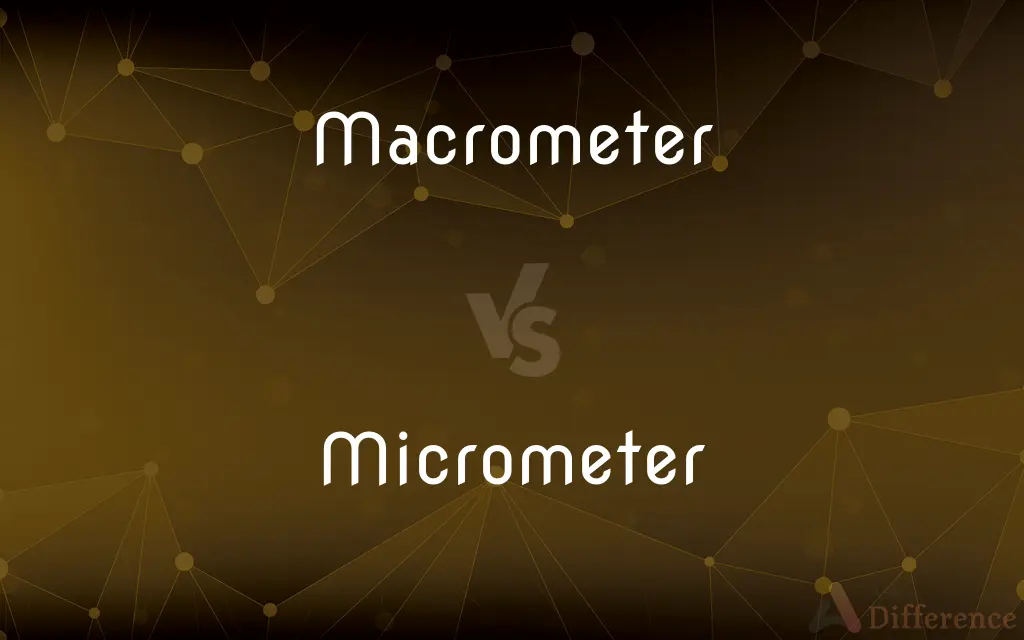Macrometer vs. Micrometer — What's the Difference?
By Maham Liaqat & Urooj Arif — Updated on February 29, 2024
A macrometer refers to instruments or devices designed to measure large distances, focusing on macro-scale measurements. A micrometer is a precision instrument used to measure very small dimensions, often in the micron range, emphasizing accuracy.

Difference Between Macrometer and Micrometer
Table of Contents
ADVERTISEMENT
Key Differences
Macrometers are tools or systems utilized for measuring relatively large physical dimensions, such as distances between geographical locations or dimensions of large structures. These devices are essential in fields like astronomy, geodesy, and large-scale construction, where vast distances or sizes need to be accurately determined. Micrometers, on the other hand, are precision measuring tools commonly used in mechanical engineering, machining, and materials science to measure the thickness, diameters, or minute dimensions of objects with high accuracy. Typically, a micrometer provides measurements in the range of one millionth of a meter, or a micron, making it indispensable for tasks requiring precise dimensional control.
The term macrometer is less commonly used in everyday language and tends to be associated more with the concept of measuring larger scales rather than a specific instrument. The design of a micrometer includes a calibrated screw mechanism, which allows for very fine adjustments to be made and read with high precision.
Macrometers deal with measurements that can span meters to kilometers or more, micrometers are concerned with dimensions that are often less than a millimeter. This stark contrast in scale highlights the different applications and importance of each type of measurement in various fields of work and research.
Macrometers might be used to survey land, measure the dimensions of buildings or bridges, or in any context where large-scale measurements are necessary. Micrometers are typically found in workshops, laboratories, and manufacturing settings, where they are used to ensure the precise fitting of components, quality control, and research and development activities.
The difference between the two extends beyond their measurement capabilities to include their usage context, precision level, and the types of measurements they are designed to perform. While both are crucial in their respective domains, the choice between a macrometer and a micrometer depends entirely on the scale of the object or distance being measured.
ADVERTISEMENT
Comparison Chart
Scale
Large dimensions (meters to kilometers)
Small dimensions (microns and millimeters)
Usage Context
Astronomy, geodesy, large-scale construction
Mechanical engineering, machining, materials science
Measurement Focus
Large distances or sizes
Very small dimensions with high precision
Common Design
Varies widely based on application
Calibrated screw mechanism for fine adjustments
Precision Level
Lower than micrometers, appropriate for its scale
High precision, capable of micron-level measurements
Compare with Definitions
Macrometer
A device for measuring large distances or sizes.
Astronomers use a macrometer to measure the distance between stars.
Micrometer
Essential in workshops for precise adjustments.
A micrometer ensures that the engine parts fit perfectly.
Macrometer
Used in geodesy for land surveying.
The construction team used a macrometer for mapping the site.
Micrometer
A precision tool for measuring small dimensions.
He used a micrometer to measure the machine part's thickness.
Macrometer
Tools for large-dimensional measurements.
Geographical measurements often require a macrometer.
Micrometer
Tool for detailed measurement in manufacturing.
The micrometer played a crucial role in product development.
Macrometer
Instruments measuring vast spaces.
Macrometers are essential for accurate large-scale construction projects.
Micrometer
Instrument for micron-level accuracy.
The lab requires a micrometer for its material science research.
Macrometer
Systems for macro-scale measurement.
In urban planning, macrometers help in assessing the layout of cities.
Micrometer
Used in machining for quality control.
Each component's diameter was checked with a micrometer.
Macrometer
A macrometer is an instrument for measuring the size and distance of distant objects. Distant in this sense means a length that can not be readily measured by a calibrated length.
Micrometer
A micrometer, sometimes known as a micrometer screw gauge, is a device incorporating a calibrated screw widely used for accurate measurement of components in mechanical engineering and machining as well as most mechanical trades, along with other metrological instruments such as dial, vernier, and digital calipers. Micrometers are usually, but not always, in the form of calipers (opposing ends joined by a frame).
Micrometer
A gauge that measures small distances or thicknesses between its two faces, one of which can be moved away from or towards the other by turning a screw with a fine thread.
Micrometer
A device for measuring very small distances, objects, or angles, especially one based on the rotation of a finely threaded screw.
Micrometer
A device used to measure distance very precisely but within a limited range, especially depth, thickness, and diameter.
Micrometer
An instrument, used with a telescope or microscope, for measuring minute distances, or the apparent diameters of objects which subtend minute angles. The measurement given directly is that of the image of the object formed at the focus of the object glass.
Micrometer
Caliper for measuring small distances
Micrometer
A metric unit of length equal to one millionth of a meter
Common Curiosities
What is the accuracy level of a micrometer?
Micrometers can offer measurements with accuracy in the range of microns, making them highly precise instruments.
Are macrometers commonly used in everyday applications?
No, macrometers are more specialized and used in fields requiring large-scale measurements, such as astronomy or land surveying.
Can a micrometer measure the thickness of a human hair?
Yes, a micrometer can measure the thickness of a human hair, which is within its capability for micron-level accuracy.
Is a micrometer suitable for home DIY projects?
While a micrometer can be overkill for some home DIY projects, it is invaluable for tasks requiring precise measurements.
Are there any safety concerns when using a micrometer?
While generally safe, care must be taken to avoid damaging the instrument or the object being measured due to improper use.
How do professionals choose between a macrometer and a micrometer?
The choice depends on the scale of the measurement required; macrometers for large distances or sizes, and micrometers for small, precise dimensions.
What industries rely heavily on micrometers?
Industries such as mechanical engineering, machining, and materials science rely heavily on micrometers for quality control and precision work.
What is the primary difference between a macrometer and a micrometer?
Macrometers measure large distances or sizes, while micrometers measure very small dimensions with high precision.
Can a macrometer be used for measuring the height of mountains?
Yes, macrometers can be used in applications like measuring the height of mountains, fitting their role in large-scale measurements.
Do macrometers and micrometers require special training to use?
Yes, both instruments require understanding and training to use effectively, especially micrometers, due to their precision.
Can micrometers measure liquid dimensions?
Micrometers are designed for solid objects; measuring liquid dimensions requires different types of precision instruments.
How do advancements in technology affect the use of macrometers and micrometers?
Technological advancements enhance the accuracy, ease of use, and functionalities of both macrometers and micrometers, expanding their applications.
How do environmental factors affect macrometer measurements?
Environmental factors like temperature and humidity can affect macrometer measurements, especially in outdoor or large-scale applications.
What is the significance of calibration in using a micrometer?
Calibration ensures the accuracy and reliability of measurements taken with a micrometer, critical for precision work.
Can digital tools replace macrometers and micrometers?
Digital tools complement but cannot fully replace these instruments, as physical measurements are essential in many contexts.
Share Your Discovery

Previous Comparison
Advertising vs. Propaganda
Next Comparison
Memo vs. CircularAuthor Spotlight
Written by
Maham LiaqatCo-written by
Urooj ArifUrooj is a skilled content writer at Ask Difference, known for her exceptional ability to simplify complex topics into engaging and informative content. With a passion for research and a flair for clear, concise writing, she consistently delivers articles that resonate with our diverse audience.
















































